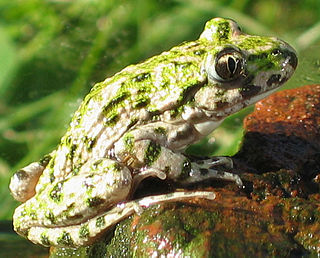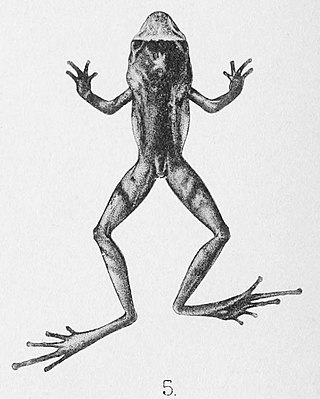
A tadpole or polliwog is the larval stage in the biological life cycle of an amphibian. Most tadpoles are fully aquatic, though some species of amphibians have tadpoles that are terrestrial. Tadpoles have some fish-like features that may not be found in adult amphibians such as a lateral line, gills and swimming tails. As they undergo metamorphosis, they start to develop functional lungs for breathing air, and the diet of tadpoles changes drastically.

True frogs is the common name for the frog family Ranidae. They have the widest distribution of any frog family. They are abundant throughout most of the world, occurring on all continents except Antarctica. The true frogs are present in North America, northern South America, Europe, Africa, and Asia. The Asian range extends across the East Indies to New Guinea and a single species, the Australian wood frog, has spread into the far north of Australia.

Bombinatoridae is a family of toads found in Eurasia. Species of the family have flattened bodies and some are highly toxic.

The Alytidae are a family of primitive frogs. Their common name is painted frogs or midwife toads. Most are endemic to Europe, but three species occur in northwest Africa, and a species formerly thought to be extinct is found in Israel.

The southern frogs form the Leptodactylidae, a name that comes from Greek meaning a bird or other animal having slender toes. They are a diverse family of frogs that most likely diverged from other hyloids during the Cretaceous. The family has undergone major taxonomic revisions in recent years, including the reclassification of the former subfamily Eleutherodactylinae into its own family the Eleutherodactylidae; the Leptodactylidae now number 206 species in 13 genera distributed throughout Mexico, the Caribbean, and Central and South America. The family includes terrestrial, burrowing, aquatic, and arboreal members, inhabiting a wide range of habitats.

The European spadefoot toads are a family of frogs, the Pelobatidae, with only one extant genus Pelobates, containing six species. They are native to Europe, the Mediterranean, northwestern Africa, and western Asia.

The parsley frogs or Pelodytidae are a family of order Anura. The family consists of a single genus, Pelodytes, which contains five species. These frogs can be found in south-western Europe and the Caucasus. The common name of "parsley frogs" comes from the common parsley frog which, because of its colouring, appears to be garnished with parsley.

Pelodytidae, also known as the parsley frogs, or rarely, mud divers, is a family of frogs. It contains a single extant genus, Pelodytes, and three genera only known from fossils. The extant species are found in southwestern Europe and the Caucasus.

The Brachycephalidae are a family of frogs confined to eastern and southern Brazil and northern Argentina. The family is composed of two externally quite different genera: the tiny, often colourful and plump saddleback toads (Brachycephalus) from Brazil, and the larger, slimmer and more drab genus Ischnocnema from both Brazil and Argentina. The family is mainly defined by molecular characteristics, and are linked by few anatomical features. It was erected from two genera of the previously large family Eleutherodactylidae, which is now split into four families.
Atympanophrys is a genus of frogs in the family Megophryidae. They range from central China south to northern Vietnam. They are commonly known as hidden-tympanum horned toads.

Leptobrachella is a genus of frogs in the family Megophryidae. Members of Leptobrachella are found throughout Asia including on Borneo and the Natuna Islands. They are sometimes referred to as Borneo frogs, slender-armed frogs, or dwarf litter frogs. The genus contains over 82 species with 25 found in China alone.

Megophrys montana is a species of frog found in Java and possibly Sumatra.
Dring's horned toad, or Dring's horned frog, is a species of frog in the family Megophryidae found in Mount Mulu in Sarawak, Borneo (Malaysia). It is the only species in the genus Sarawakiphrys. Its natural habitats are tropical moist montane forests and rivers.
The rough-skinned horned toad or Tonkin spadefoot toad is a species of frog in the family Megophryidae. It is found in southern China, northern Vietnam, and northern Laos.

Philautus kempii is a species of frog in the family Rhacophoridae. It is known with certainty from its type locality, Upper Rotung in Arunachal Pradesh, Northeast India, in the area also claimed by China. It is also reported from Arunachal Pradesh in general as well as from extreme eastern Tibet; these might represent another species. Very little is known about this species, and even its taxonomic validity remains uncertain.

The Pelobatoidea are a superfamily of frogs. They typically combine a toad-like body shape with a frog-like, pointed face. Phylogenetically they stand between primitive frogs on the one side and higher frogs on the other and are therefore – among other things by characteristics of bone construction – in the suborder Mesobatrachia.
Leptobrachella lateralis is a species of frog in the family Megophryidae. It was first described by John Anderson (1871), who originally named it Ixalus lateralis. The holotype is lost and its exact origins are uncertain, but it was likely collected "from some portion of the surrounding region [of Bhamò]", Myanmar. It is only known with confidence from the region of its type locality and from Nagaland in Northeast India. Its range might extend into Yunnan, China. It is sometimes called Nagaland Asian toad or Nagaland leaf litter toad.

Pelobatrachus is a genus of frogs in the family Megophryidae. It was formerly synonymized with Megophrys until 2021, when it was revived as a distinct genus. They inhabit Southeast Asia, namely the Malay Peninsula, Sumatra, Borneo and the Philippines. Their common name is clay horned toads.
Megophrys selatanensis, the South-Sumatran horned-frog, is a species of frog from the genus Megophrys native to Indonesia. The species was scientifically described in 2021.

Xenophrys apatani, is a species of horned toad of Xenophrys genus, discovered from Arunachal Pradesh in Northeast India. The species is named after Apatani tribe of Arunachal Pradesh.















